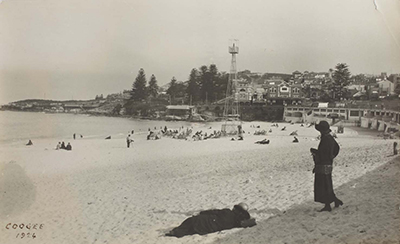Coogee Shark Tower
- Published Date
- 08/06/2022
- News Topic
- Beaches & Lifeguards, Council, Heritage, Art & Culture

While the devastation of an attack will never change, our approach to sharing the ocean with sharks certainly has. Find out how Council responded to two attacks at Coogee a century ago.
Sadly, the recent tragedy at Little Bay was almost 100 years to the day since Coogee had been shocked by a similar event. On 4 February 1922, 18-year-old Coogee Surf Life Saving Member, Milton Singleton Coughlan, was killed in a shark attack. Less than a month later Mervyn Gannon was also attacked at Coogee Beach, and later died of his injuries.
These were two of many shark attacks at beaches across Sydney and the nation in the 1920s. To try and put the Australian population’s fear of shark attacks into an historical contest, you only need to review how widely the 1922 Coogee tragedies were reported in the media across Australia. The news of the heroic and valiant attempts to rescue Coughlan at Coogee by John Chalmers (Coogee SLC) and Olympian Frank Beaurepaire was reported as front-page news in the Geraldton Express (WA) three weeks later on 22 February 1922. News of the tragedy spread across the length and breadth of the country.
In early 1922, the NSW state government moved swiftly and brutally, deploying its state trawler and catching 25 sharks, not long after Coughlan and Gannon died at Coogee. A hunting spree ensued when the state authorities offered a £50 reward for sharks caught in Coogee Bay. It is a risk mitigation strategy that is hard to comprehend in our contemporary society.
In response to this same threat, Randwick Municipal Council moved swiftly to erect the first of two galvanised iron Shark Towers (or lookouts) on Coogee Beach.
The first Coogee tower was constructed in September 1922 and was operational shortly after, in time for the summer swimming season of 1922/3. The controversy surrounding the location of the initial tower was reported in the Sydney newspapers, testament to a nation searching for answers to improve beach safety at our iconic beaches.
The specifications of the tower to be constructed on the Coogee sands with diagrams and detailed description of its features were published widely in the press. It was said that the proposed location of the tower and the angle of the sun throughout the day, was not the most ideal vantage point. The published diagrams followed the movement of the sun’s rays across the day. It was even mooted that a tower on the clifftop at Dunningham Reserve, looking south, would be more advantageous.
Desperate for any mechanism that would alert swimmers to the presence of sharks, Council resolved to proceed with the construction of the first tower, in the middle of the beach. The Coogee shark towers had a ‘bird nest’ lookout on top with an electric bell to quickly warn swimmers. A backup semaphore system indicated if the alert was for the presence of sharks in the bay, or a swimmer in distress. This second signalling feature was primarily to assist surf lifesaving volunteers, but quickly became known as a call to action by anxious bathers.
The community’s fear of shark attack was widely felt by swimmers across the nation and would only escalate as the 1920s and 1930s progressed. These marine animals were referred to in the media as ‘public enemy no. 1’ and ‘those fiends of the ocean’. Through the prism of history, it is hard for us to imagine there was little public empathy or respect for these natural inhabitants of our marine environment.
Another contemporary shark mitigation strategy - the concept of a ‘shark proof net’ at Coogee Beach - had long been talked about. This concept had been around since at least 1912, as the Council’s Press Clippings volumes in our corporate archives reveal.
The first ‘shark proof net’ at Coogee was installed after further shark ‘scares’ at Bondi and Coogee in November 1922. The first Coogee shark tower was not preventing further attacks and Council was desperate to quell the public disquiet, apparent Sydney-wide, but especially with local swimmers. In addition to the first shark tower, it was resolved to install the first shark proof enclosure that would allow over 5000 people to surf comfortably at Coogee Beach. Despite the elected officials’ valiant efforts and belief that this net would ‘resist the heaviest seas’, it was washed away before there was even time for the official opening.
By March 1925, a further shark attack saw sixteen-year-old Jack Dagworthy, another Coogee SLSC member, having his left leg amputated. With so many shark attacks, Council was again left searching for additional solutions to protect bathers. By September 1925, ‘The Sun’ Sydney newspaper reported that the second Sydney shark tower was almost complete - at the southern end of the beach adjacent to the Coogee SLSC. But this is far from the end of the story. The later construction of the Coogee Pier and the second shark proof net is a whole other story.
